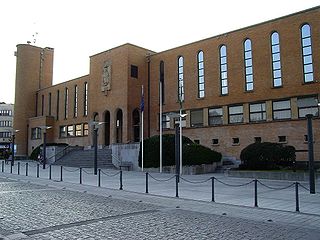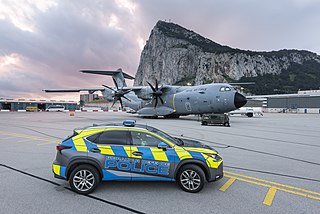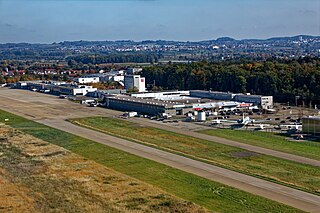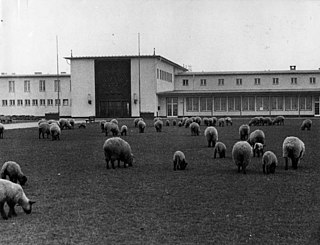
Moffett Federal Airfield, also known as Moffett Field, is a joint civil-military airport located in an unincorporated part of Santa Clara County, California, United States, between northern Mountain View and northern Sunnyvale. On November 10, 2014, NASA announced that it would be leasing 1,000 acres (400 ha) of the airfield property to Google for 60 years.

Evere is one of the 19 municipalities of the Brussels-Capital Region (Belgium). As of 1 January 2022, the municipality had a population of 43,608 inhabitants. The total area is 5.08 km2 (1.96 sq mi), which gives a population density of 8,503/km2 (22,020/sq mi). In common with all of Brussels' municipalities, it is legally bilingual (French–Dutch).
The Societé anonyme belge d'Exploitation de la Navigation aérienne, better known by the acronym Sabena or SABENA, was the national airline of Belgium from 1923 to 2001, with its base at Brussels National Airport. After its bankruptcy in 2001, SN Brussels Airlines was formed through a takeover of former subsidiary Delta Air Transport and took over part of Sabena's assets in February 2002, which became Brussels Airlines after a merger with Virgin Express in March 2007. The airline's corporate headquarters were located in the Sabena House on the grounds of Brussels Airport in Zaventem.

Brussels Airport is an international airport 6.5 NM northeast of Brussels, the capital of Belgium. In 2019, more than 26 million passengers arrived or departed at Brussels Airport, making it the 24th busiest airport in Europe. It is located in the municipality of Zaventem in the Province of Flemish Brabant in the Flemish Region of Belgium. It is home to around 260 companies, together directly employing 20,000 people and serves as the home base for Brussels Airlines and TUI fly Belgium.

RAF Gibraltar is a Royal Air Force station on Gibraltar. No military aircraft are currently stationed there, but RAF, Commonwealth and aircraft of other NATO nations will periodically arrive for transient stopovers, exercises, or other temporary duty. Administered by British Forces Gibraltar, the station is a joint civil-military facility that also functions as the Rock's civilian airport – Gibraltar Airport, with the civilian airport's passenger terminal building and apron facilities located on the north side of the runway while the apron and hangar of RAF Gibraltar are located on the south side of the runway.

A hangar is a building or structure designed to hold aircraft or spacecraft. Hangars are built of metal, wood, or concrete. The word hangar comes from Middle French hanghart, of Germanic origin, from Frankish *haimgard, from *haim and gard ("yard"). The term, gard, comes from the Old Norse garðr.

Mannheim City Airport is a minor regional airport serving the German city of Mannheim. It is mainly used for general aviation.

Friedrichshafen Airport is a minor international airport 1.9 miles (3 km) north of Friedrichshafen, Germany, on the banks of Lake Constance. It is the third biggest airport in the German state of Baden-Württemberg after Stuttgart and Karlsruhe/Baden-Baden and served 559,985 passengers in 2015. Friedrichshafen features flights to European metropolitan and leisure destinations. Due to its proximity to the Austrian Alps it is also heavily used during the winter by skiing tourists.

Šiauliai International Airport is an airport located within Šiauliai Air Base which is a major military facility of the Lithuanian Air Force and one of the air bases of the NATO Baltic Air Policing mission. The joint-use airport is also known by its historic name of Zokniai aerodrome and is located 7 kilometres (4.3 mi) southeast of the city of Šiauliai in northern Lithuania.

Aachen Merzbrück Airfield is an airfield located near Aachen, Germany.
Melsbroek Air Base is a Belgian Air Component facility in Steenokkerzeel, 6.5 NM northeast of Brussels, the capital of Belgium. It is located on the northern side of Brussels Airport, with which it shares runways and ground and air control facilities.

Saint-Simon – Clastres Air Base is an abandoned military airfield, which is located approximately 3 km (2 NM) northwest of Clastres and east of Saint-Simon, both communes in the Aisne department of the Picardy (Picardie) region in France. It is approximately 116 km (63 NM) north-northeast of Paris.
Melun Villaroche Aerodrome is an aerodrome located 8.5 km (4.6 NM) north of Melun, a commune in the Seine-et-Marne department in the Île-de-France region in north-central France.
Laon-Athies Air Base is an abandoned military airfield, which is located near the city of Laon in the Aisne department of France.

Péronne-St Quentin Airfield is a recreational aerodrome in France, located 11 miles (18 km) west of Saint-Quentin; 121 miles (195 km) north of Paris. It supports general aviation with no commercial airline service scheduled.

Cambrai-Niergnies Airport is a regional airport in France, located 3 miles (4.8 km) south-southeast of Cambrai; 100 miles (160 km) north-northeast of Paris.

Værnes Air Station is an air station of the Royal Norwegian Air Force located in the municipality of Stjørdal in Trøndelag county, Norway. It is co-located with Trondheim Airport, Værnes, which is owned and operated by Avinor. As an air station, the aerodrome is primarily used for the Marine Corps Preposition Program Norway, which involves the United States armed forces stationing equipment at Værnes and other facilities in the Trondheim region of central Norway. The Værnes military installations contain place for up to six aircraft of the size of a C-5 Galaxy and barracks to house 1,200 soldiers. It also serves the Home Guard, including its training center and the headquarters of the Trøndelag District (HV-12). Formerly, the air force's pilot school was located at Værnes.

Trier Air Base, also known as Trier Euren Airfield, is a former military airfield located in the southwest of Trier, a city in Rhineland-Palatinate, Germany. It was established in 1910. During World War I it was used by the Deutsche Luftstreitkräfte as both a Zeppelin and military airfield. Later, it was used by the Air Service, United States Army, Deutsche Luftwaffe, the United States Army Air Forces, and NATO forces until being closed in 1977, when the airfield was converted into an industrial park.

Locarno Airport, mil ICAO code LSMO, also known as Locarno-Magadino Airport, is an airport located near the city of Locarno, Ticino, Switzerland. It is a mixed civilian and military airport. The airfield is used simultaneously by civilian aircraft and the Swiss Air Force from the "airfield command Locarno". Although they use the same runways, the Swiss Air Force has its own taxiways and parking and a large hangar. It is located in the community of Gordola, seven kilometers east of the Locarno city center. The nearest stop to the Swiss Federal Railways is the 2 km distant station Riazzino of railway Giubiasco Locarno.

Butzweilerhof is a former civil airport of Cologne in West Germany. It was established as a training airfield in 1912, and saw airline service from 1922 until the 1950s. It was replaced by the Cologne Bonn Airport. The airport buildings from 1935-36 are registered as listed monuments, and a rare example of airport architecture from the interwar period. From 1951 to 1967, it was operated by the Royal Air Force as RAF Butzweilerhof.

















